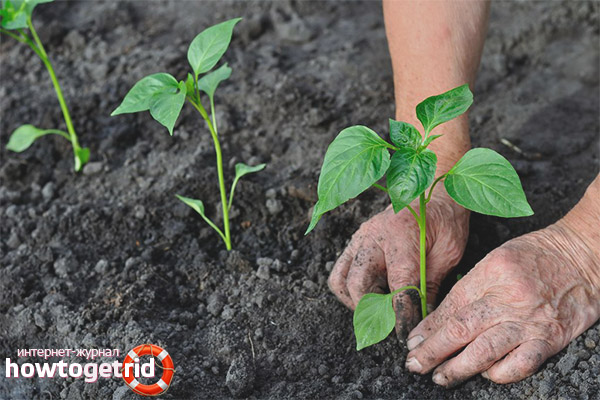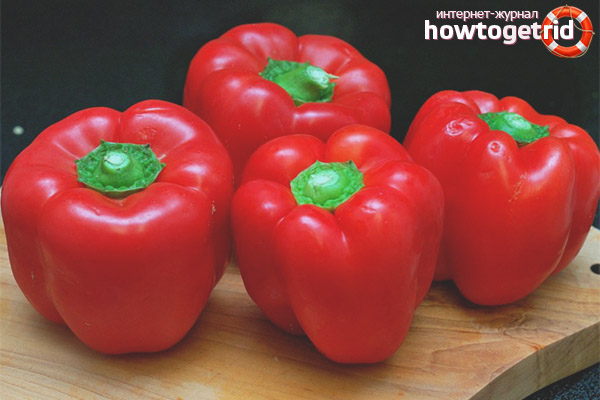The content of the article
There are not so many cultures that are especially popular in summer cottages. These are tomatoes, cucumbers, potatoes, cabbage. And of course, sweet pepper. Many dishes are made from it, eaten raw, frozen, canned food. And in order for the vegetable to give a good harvest, specific varieties are chosen - unpretentious and prolific. One of these varieties is called Bogatyr.
Description and main characteristics
Variety Bogatyr was bred in the late 80s of the last century. Suitable for growing throughout Russia. In the warm southern areas you can plant on the street, in the rest, where it is not so warm, it is better in a greenhouse. It is considered a mid-ripe crop; vegetation from germination to full maturity of the fetus lasts 118-120 days.
Bush:
- Height from 40 to 60 centimeters.
- The bushes are spreading, many branches and branches, so it is recommended that when planting, maintain a distance between them of 40-50 centimeters.
- There are a lot of leaves, the color of the foliage is dark green, slightly wrinkled.
- Needs a mandatory garter so that they do not break under the weight of the fruit.
Fetus:
- The shape is conical, the surface is covered with numerous tubercles.
- The fruit is four-chambered.
- The peel is thick - up to 5 millimeters.
- The color of fully ripened pepper is bright red.
- The average weight of the fetus is 210-230 grams.
- The taste is sweet, sourness and bitterness are absent.
- From 1 ha, gardeners harvest about 50 tons of vegetables.
Advantages and disadvantages
Advantages:
- High yield.
- Unpretentiousness.
- Great taste.
- Resistant to low temperatures, easily tolerates differences.
- High immunity.
- Transportability.
- The fruits persist for a long time.
Disadvantages:
- Water is afraid of a lack, therefore it needs to be watered constantly.
- Does not want to bear fruit in shady areas.
Planting, growing
If your seeds are planted, then they need to be sorted, leaving only large and intact. Culling should be done using a normal salt solution. 40 grams of salt is added per liter of water, and the selected seeds are dropped into the resulting solution. After mixing, those that are on the surface must be collected and discarded. And at the bottom there will be suitable seeds. The selected ones are washed with water and disinfected with a weak solution of potassium permanganate. Then gauze is taken, seeds are wrapped in it, the cloth is poured with water and put in a warm place (+ 21- + 23 degrees), where it lies for about 7-8 days. All this time, the fabric needs to be moistened, but pouring is not recommended - because air is needed for growth.
Sowing
Landing is carried out in late February or early March. The capacity for seedlings is recommended to be treated with a weak solution of potassium permanganate. Soil composition: two parts of garden humus-rich land and one part of sand and compost. Seeds are buried in 2 centimeters from each other to a depth of 1-1.5 centimeters. Polyethylene is pulled on top and the container is placed in the light. The temperature regime should be around +25 degrees Celsius. When the first sprouts appear in 7-12 days, the film should be removed. Within a week after this, you need to try to maintain the temperature + 16- + 18 degrees, then increase to + 20- + 25. It is necessary to regularly ventilate the room and maintain high humidity up to 70 percent.
Care
- Sprouts are poured with settled water. It must be remembered that it is important not to dry the pepper, and not to water too abundantly. You should visually watch when watering is required.
- In order for the root system to develop well, the seedlings should be nibbled - cut a piece of the plant over the fourth to fifth internode with scissors.
- Also, seedlings need a lot of light so that the seedlings do not stretch and do not thin out. To do this, put fluorescent lights and turn them on when dark.
Pick
You need to dive the plant after the appearance of the second leaf. It is important that after a dive, a temperature of at least + 21- + 23 degrees should be observed, otherwise the sprouts will stop growing.
About 15-20 days before transplanting, seedlings need to be hardened. To do this, the pots are taken out to the open air, first for half an hour, and then the time is increased. This process gives the plant more vitality and enhances immunity.
Landing on the site

Seedlings are planted in a permanent place after reaching 20-25 centimeters in height, when each bush will have 7 leaves. It is advisable to select the area lit, without shading. The best place for growth is the place where there used to be cucumbers, root vegetables, pumpkin, peas, cabbage.
The transplant process is as follows:
- The soil is dug up with a bayonet depth, compost is added to it.
- Prepared are holes located 10-15 centimeters from each other and a depth of 40-50 centimeters.
- Seedlings with a lump of earth move into the hole.
- The hole is half filled with soil, one third of a bucket of water is poured into it. When water is absorbed into the earth, the pit is completely filled with earth.
Care
Pepper care Bogatyr is quite simple and standard - to weed the ground, water and fertilize.
Watering
Moisturizing is a prerequisite for good development and fruiting. First, the plant is watered during planting, then after 5 days, after - according to the schedule. Before flowering, once a week is enough, when flowers are formed and during fruiting, twice a week.
Bushes are watered in the morning or in the evening when there is no sun. For this, only warm, standing water is used (cold water stops development). In order not to form a crust around the bush, it is watered on one side, and the soil is loosened on the other. Tomorrow is the opposite. Then the roots develop normally.
Top dressing
The plant should be fed three times:
- 14 days after planting. 10 grams of urea, 5 grams of superphosphate are added to a bucket of water and diluted. It is necessary to ensure that top dressing does not fall on the leaves.
- When buds form. For 10 liters of water, one teaspoon of urea and potassium and 2 tablespoons of superphosphate are added. Under each bush, a liter of solution is poured. Thanks to this, the ovaries are better formed.
- When the fruits ripen. 2 teaspoons of potassium salt and superphosphate are placed in a bucket of water. Also, under each bush, it pours out per liter and then the fruits will be juicy.
Trimming, Garter
Every 10 days, it is recommended to trim the side branches so that they do not pick up moisture and nutrients intended for the fruit.
The hero needs a garter. It is carried out after the bush reaches a height of 60 centimeters. The branches are fragile, so it is better to tie each one separately to a support driven in near the bush.
Diseases
The Bogatyr has well-developed immunity to the main diseases affecting the culture: vertex rot, tobacco mosaic, verticillosis. But there are those that carry danger.
- Sepioriosis The plant is covered with gray spots bordered by a dark strip. It is treated with a solution of phytosporin.
- Alternarosis. The fruits are covered with watery spots, and the leaves are dark brown. Helps spraying with burgundy liquid.
- Blackleg. With this disease, the bottom of the stem rots. It does not give in to treatment, the plant needs to be destroyed, and the earth to be disinfected.
Pests
The most dangerous pests are slugs, spider mites and aphids.
- Slug. You can get rid of them simply - around each seedling you need to loosen the earth. To be sure - sprinkle with ash or hot pepper.
- Spider mite. Popular methods cope well with this pest: onion or garlic broth, soap solution are used.
- Aphid. She is able to destroy the bush in one to two days. For processing, kalbofos is used.
To prevent diseases and pests, you need a little - to remove weeds in a timely manner and carefully dig the soil after harvesting.
For growing pepper Bogatyr is not required when leaving too complex events. It is enough to show a little concern for the culture and be careful - and then each bush will delight with two or three kilograms of delicious peppers.
Video: Bogatyr pepper










Submit